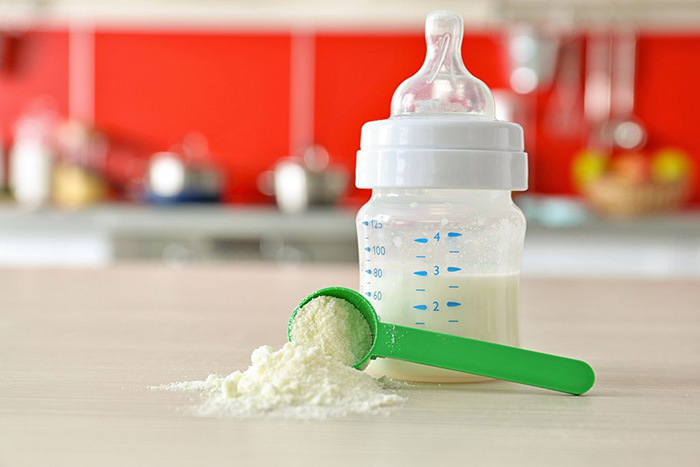

19.06.2009, 12:27
Solnyffko
19.06.2009, 12:38
Girls who have children in the NE, please tell me how to accustom the baby to the mixture. My son is 4 months old, only breastfeeding, over the past 2 months he has added 400 g, he eats day and night every 2 hours, at our age this is often, according to the pediatrician. She said after each feeding to give 30 ml of the mixture, I bought Agusha Gold, gave it before breastfeeding, and between, and after, she doesn’t take it in any, closes her mouth, turns away and spits out. I've been trying for 3 days and it doesn't work. Can I buy another mix? Or are they all about the same taste? What to do? I feel like there is less and less milk. He doesn't like the mix.
We have the same thing - we tried both Agusha and Nutrilon. I started making purees. But how to be with a mixture - I can’t imagine. But we don't take a bottle at all :(
Young mom
19.06.2009, 12:40
Feed more often, there will be more milk. The mixture is a direct way to curtail GW. Read the articles in the Milk Fairies group in Vkontakte and call tel. GV consultant 904-21-51. My son is 3 months old, he eats every hour, I don’t worry, as long as he is healthy and gets immunity from my milk. Of course, pediatricians swear, in their opinion, the child should eat every 3 hours. But I feed on demand, and I don't have much milk, that's why I feed so often. Over the past month, they added 650 grams, before that it was 900 and 1200, in the first months they add more, then less. It seems to me, small increases because you rarely apply. And then, each kid adds individually. I met kids who add 300 grams on IV.
19.06.2009, 12:41
I started to supplement NANNY's sister - she spat, NAN1 - too, but NAN sour milk went for a sweet soul. But I only gave it at night. It's bad that they don't sell samplers for mixtures. A neighbor spent a lot of money on similar research and had a lot of open cans nutrition. The result - they eat Nutrilon., But it took about 2 months of gradual change of mixtures. But if the child is on breastfeeding, he simply may not recognize the pacifier (it happened with us - they barely picked it up).
Try a different mixture. But this is my IMHO.:ded:
amaranth
19.06.2009, 12:42
Firefly_80
19.06.2009, 12:48
It also seems to me that it is better not to introduce a mixture, but mashed potatoes and breastfeed more often. Make porridges on the mixture ...
19.06.2009, 13:02
TyumenNOCHKA
19.06.2009, 13:13
4 months early to introduce complementary foods. Even porridge. I planned to start at 6 am. He also drinks Plantex from a bottle, and gave expressed milk a couple of times - he drank with pleasure. And no mixture. Breast give every 2 hours, much more often. I wanted to give the mixture at least at night, so that I could sleep for at least 4 hours. Otherwise, I will soon fall from lack of constant sleep, where I stood.
If a child asks for breasts so often, it means that something is bothering him ... the fact that you gained 400g is not an indicator. How much do you weigh? Get tested, maybe your tummy hurts ?! leaked, after 40 minutes he could have eaten a lot, but HIPP is fatter, they only ate it ...: flower:
19.06.2009, 13:17
maybe he doesn't like the mix. There are such picky kids :) serve only a certain mixture. My friend didn’t have a baby or something, but Nutrilak went well.
In general, try to be patient and persistently apply to the chest! pump. Nature, it is cleverly arranged, milk flows as much as the baby eats. It's just that many people are lazy and don't want to suck the hind milk. Or is it hard for them...
19.06.2009, 13:38
The only option is to methodically sort through all the mixtures!
We tried both NAN and NAN fermented milk, Tutteli, Samper, Nutrilon, Nutrilon Gold, as a result, Gold went a little better, and we started with it a little bit. And now, don’t let everything eat, as they say, there would be an appetite: 0064:
Firefly_80
19.06.2009, 13:47
4 months early to introduce complementary foods. Even porridge. I planned to start at 6 am. He also drinks Plantex from a bottle, and gave expressed milk a couple of times - he drank with pleasure. And no mixture. Breast give every 2 hours, much more often. I wanted to give the mixture at least at night, so that I could sleep for at least 4 hours. Otherwise, I will soon fall from lack of constant sleep, where I stood.
Well, if it’s too early to introduce complementary foods, then of course try other mixtures ... It seems to me impossible to accustom a child to a certain mixture that is convenient for you ....
If you don’t want any mixture, try all the same porridge on the mixture or on your milk. It's better than a hungry child.
I just had the same problem. I didn’t drink the mixture at 4 months - but I began to eat porridge with pleasure: support: And now, by the way (we are 6 months old), and she drinks the mixture quite decently ...
P.S. Personal observation - all my mothers I know who began to introduce complementary foods after 6 months faced the problem that it is very difficult to feed the baby with food from a spoon ...: 001:
19.06.2009, 13:54
http://www.forum.littleone.ru/showthread.php?t=1491267 Maybe something will help you.
Thanks, appreciated. We have a bottle of Avent, 1 drop, plantex and expressed milk from it drinks. The mixture may be a little thicker, but it still flows, because everything is white in his mouth, but then he opens it, turns it on its side and everything flows out.
OctoberAbdomen
OctoberAbdomen
19.06.2009, 13:56
4 months early to introduce complementary foods. Even porridge. I planned to start at 6 am.
Why early? :016:
Firefly_80
19.06.2009, 14:08
Why early? :016:
For example, we introduced complementary foods at 3 months, but there was no problem of refusing complementary foods. like many who later introduced 6 months.
1000
19.06.2009, 14:16
1000
So I don't think it's too early. After all, everyone recommends introducing complementary foods from 4-6 months. I always understood that from the age of 6 - this is when there is a lot of milk, the tests are good, there are no constipations, or, conversely, a terrible allergy to everything ...
Another thing is that you have to fiddle a lot ... cook porridge, somehow reclining to seat the child, then wash and wash almost everything (I remember these first complementary foods :))) But then it is much easier! But you still have to start!
Pediatricians recommend introducing complementary foods to children for breastfeeding from 6 m, for IV from 4, we are still at full breastfeeding. The child does not have constipation, on the contrary, he poops 4-5 times a day, the tests are good. Everything is fine, except for one thing: from constant use, the chest hurts and I constantly want to sleep, I am alone at home with my son, there is little help from my husband: at 7.30 I went to work, at 20.00 I came. I wanted to make life a little easier for myself and give the mixture at night. But apparently not fate.
Some mothers are forced to switch to formula milk when breast-feeding impossible. However, here parents may encounter a problem when the baby does not eat the mixture. But this nutrition is extremely important for the crumbs, even if he is already switching to complementary foods. The volume of complementary foods at first is not enough for the baby, so it should be supplemented with breast milk or formula until the baby completely switches to adult food. In addition, some babies switch to artificial feeding before the start of complementary foods.
Modern milk formulas are developed using new technologies and are maximally adapted to the composition of breast milk. Today, various types of food are produced that are suitable for different categories of children, including newborns, allergies, premature babies and babies with insufficient body weight, a child with a lack of any vitamins or elements.
Of course, no formula can replace mother's milk, but sometimes parents have no other choice. In this case, it is important to choose the right food for the crumbs and organize artificial feeding. When the baby does not eat formula or the baby refuses breast milk, he does not eat enough and does not receive important elements and nutrients that the baby needs for harmonious growth and development. In this article, we will learn what to do if the child refuses formula.
First of all, it is important to understand why the child does not want to eat. Having determined this, you can eliminate the cause, and then the baby will eat properly and fully, according to the norm and recommendations of pediatricians. Let's take a closer look at the reasons for the refusal of the child from the mixture.
Often the child is not hungry and does not need as much food. Children older than 4-5 months are already switching to more infrequent feedings, the intervals between which become longer, but at the same time, one portion size also increases. Therefore, by the time of feeding according to the old regimen, the baby may not yet get hungry.

As practice shows, a newborn eats about seven to eight times a day with an interval of three hours. Milk formula for crumbs at 4-6 months can be given every 3.5-4 hours. If the child feels well, develops and grows normally, there is nothing wrong with the fact that he will eat less, no. If the baby refuses to eat, offer the mixture again after 30-40 minutes.
Don't overfeed your baby. Due to overfeeding, the child will not only refuse the next feeding, but will also feel uncomfortable. As a result, flatulence increases and weight increases, abdominal pain, nausea and vomiting may appear. Some children may develop food allergy, obesity and even diabetes. To avoid complications, stick to a normal diet.
The daily norm of the mixture for a child up to four weeks is up to 120 ml. For children of one to three months, it reaches 150-180 ml, at three to five months it increases to 180-200 ml. After four to five months with the introduction of complementary foods, the daily volume of mixtures is gradually reduced.
Many babies don't eat formula at the start of solid foods. The taste of adult food may seem more interesting and varied to babies than fresh milk. In this case, it is recommended to reduce the amount of mixtures, but you cannot completely refuse such supplementary feeding!

The first complementary foods for artificers begin to be introduced as early as four to five months. As the first adult dishes in the baby's menu, they include vegetable purees and dairy-free gluten-free cereals, then the child begins to be given fruit purees, juices and compotes. How to introduce complementary foods into the baby's diet, tell complementary foods for formula-fed babies.
After the end of lactation, lack of breast milk, with a serious illness, separation from the mother and for other reasons, parents are forced to transfer the child to artificial feeding. Then the baby can be naughty and not take any milk formula. In this case, you need to be patient, choose the right food and taste that the baby will like and will not cause digestive problems.
Health problems reduce appetite or force the crumbs to refuse food altogether. Common colds and fever can be among such problems. After all, adults during the flu or SARS also want to eat less, and many cannot eat at all. In addition, newborns and babies up to 3-5 months often suffer from colic and bloating.

Other problems in this category include pain in the ears and throat when it hurts for a child to swallow. The baby cannot comfortably eat milk formula from a bottle and with a blocked spout. In this case, special aspirators for newborns, which easily and comfortably remove accumulated fluid and mucus from the nasal passages. For colds, pain in the ears and throat, jaw, with severe indigestion, be sure to contact your pediatrician!
Cutting teeth and pain in the gums are a common reason for a baby's refusal to eat. During this period, the baby experiences pain and inflammation, because of which he feels discomfort and cannot eat normally. Some children even have diarrhea or nausea, which also causes them to refuse food.
Eating and having a bottle with a pacifier in your mouth only reinforce the negative feelings. In this case, you need to wait and do not force-feed the baby. By the way, special children's medicines reduce pain and discomfort. teethers for teeth.
An improperly selected and prepared mixture is a common reason why a baby does not eat the mixture well. Today, manufacturers offer a lot of different mixtures, and it is important to choose proper nutrition. Remember that the composition can cause allergies in a child, disrupt the functioning of enzymes. In addition, it may not taste like it. It is especially difficult for babies to switch to artificial mixtures if they have been on breastfeeding for a long time.
![]()
It is important to choose a mixture according to the age and needs of the child. When choosing, consider the characteristics of the body of the crumbs and consult a pediatrician. Prepare food according to the instructions and dilute the powder correctly!
Often a change in the mixture and taste that the baby is used to leads to the fact that he eats little or refuses to eat. Therefore, if you have found a suitable formula, do not change products unless it is necessary for age. But in rare cases, it happens the other way around, when the crumbs are already tired of the taste. Then try another product. But before changing, be sure to consult a pediatrician!
If your child is allergic, choose a hypoallergenic goat milk formula marked “GA”. For newborns and babies up to six months, highly adapted and adapted products with the designation “1” are chosen. For children older than six months, partially adapted and casein mixtures with the label “2” are suitable.
For children older than a year, milk formulas “3” are chosen, and for a premature baby and with a lack of weight, the product “0” or “Pre”. Fermented milk mixtures are classified as clinical nutrition and are given to babies with frequent constipation and regurgitation, stool disorders and digestive disorders. You will find more information on how to choose and prepare a formula for babies, as well as a rating of the best products.

If the baby refuses the formula bottle, it may be uncomfortable for the baby to eat. An improperly fitted or new, still hard nipple can reduce appetite. Choose a comfortable soft nipple with a suitable shape and a medium-sized hole. Too large a hole will lead to increased milk flow, as a result, the baby will choke during feeding and swallow excess air. By the way, this leads to bloating and frequent profuse regurgitation.
Too small a hole, on the contrary, makes it difficult to supply milk flow. As a result, the baby lacks strength, air and nutrition itself. It is advisable to use the same pacifier model that the baby is used to. In addition, when choosing, follow the recommendations for the age of the child, which are indicated on the product packaging.
Mixtures that can replace breast milk- a lot, they are all designed and produced from different manufacturers and for the needs of kids. It is best if the child eats the same milk mixture that suits him and nourishes the body of a small person. However, many mothers are faced with such a problem when a child for various reasons refuses the mixture. This is often worrisome, because if the child does not eat enough formula per day, he will not receive the substances necessary for his body and will not grow properly.
You need to understand that the reasons for a child’s refusal to mix are very different, many of them are quite objective and should not make parents worry. Before you panic, you should understand.
The first, and very often the main, reason that the baby refuses the formula is the reluctance to eat because of satiety. Over time, mom will understand what portion should be for a certain age, and how many hours this food will last. And at first, parents may think that the child is constantly hungry. Do not force him to eat if he refuses the mixture. You can try to offer the baby to eat after 30-40 minutes.
Another common reason for refusing the mixture is teething, which entails a general malaise of the baby. In some children, this process is sometimes accompanied by other digestive disorders - nausea or diarrhea. In addition, the child's gums may hurt, and the presence of the bottle in the mouth increases the pain. Parents are advised to be patient and wait out this period, if in a few days the child eats less than usual, there will be nothing to worry about.
Sometimes it happens that the child does not like the mixture that the mother offers. That is why it is better to choose one mixture that he will like and like, and feed the baby to her constantly. The same applies to the choice of bottle and nipple, the child may refuse to eat if he is uncomfortable. After trying several different options, you need to find the right one and do not change it again.
Abdominal disease or other ailments can also be a reason to refuse the mixture. An attentive mother will immediately notice that something is bothering the child, and will be able to find the reason for this in order to try to eliminate it.
Most often, children are happy to eat mixtures at the time they are supposed to eat. If the baby refuses to eat, do not panic, it is better to calmly figure it out. possible reasons and ways to eliminate them.